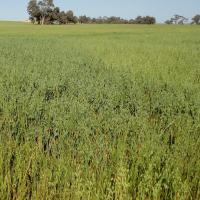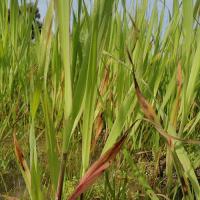Diagnosing nitrogen deficiency in oats
Nitrogen deficiency is the most common nutrient deficiency in oats especially during cold, wet conditions and in well-drained soils in high rainfall areas.
What to look for
- Light green to yellow-orange plants particularly on sandy soils or unburnt header or swathe rows
- Double sown areas have less symptoms if nitrogen fertiliser was applied at seeding
Paddock
- Short thin pale green young plants with fewer tillers.
- Symptoms first occur on oldest leaf, and then moves to progressively younger leaves with symptoms progressing to tip reddening and death that progresses to the base until the leaf is brown and withered.
- As deficiency becomes more severe leaf tips become orange-red. As tissue dies it turns dark brown and leaf margins often roll upwards to form a tube.
- Stems may become red.
- Nitrogen deficient plants develop more slowly than healthy plants, but maturity is not greatly delayed.
- Reduced head size, grain yield and protein levels.
Plant
What else could it be
| Condition | Similarities | Differences |
|---|---|---|
| Diagnosing waterlogging and salinity in oats | Pale plants with oldest leaves most affected. | Differences include root browning or lack of feeder roots and wet soil |
| Diagnosing molybdenum deficiency in cereals | Pale poorly tillered plants | Difference is that molybdenum deficiency affect the middle leaves first and cause white heads, shrivelled grain and delayed maturity. |
Where did it come from?

Low organic matter

Wet conditions
- Nitrogen deficiency can occur on most WA soils but is most common in the following situations;
- In cold, wet conditions that slow nitrogen mineralisation and the uptake of nitrogen
- Soils with very low organic matter
- High rainfall on well-drained soils and soils with sandplain traffic pans can result in nitrogen leaching.
Management strategies

Spraying foliar

Top dressing

- Nitrogen fertiliser or foliar spray.
- There is a risk of volatilisation loss from urea or (ammonium sources of nitrogen on alkaline soils) when topdressed on dry soils in dewy conditions. Losses rarely exceed 3% per day
How can it be monitored?

Tissue test

Soil test

- Use whole-top plant test to diagnose suspected nitrogen deficiency and compare paired good/poor plant samples where possible. Critical N concentration decreases as the plant ages/matures. Critical N value for whole shoots is about 5 % at tillering decreasing to 1.5 % at the boot stage.
- Nitrogen soil testing is of limited value for most soils unless used in conjunction with other rotational, soil type and rainfall information.
- Tools such as the Select Your Nitrogen calculator that combines 0-10 cm soil test organic carbon, soil type and legume history are valuable for calculating nitrogen fertiliser requirement.
Where to go for expert help
Page last updated: Friday, 10 July 2015 - 3:46pm




